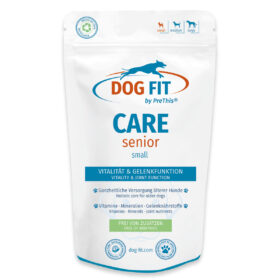Calcium for dogs
Calcium for strong teeth, bones and muscles
Calcium is an essential mineral for dogs, which plays an important role in the normal function of teeth, bones, muscles and metabolic processes. Around 99% of the calcium in the body is found in bones and teeth – a stable foundation for health and mobility.
Calcium: More than just a building block
In addition to supporting bones and teeth, calcium performs many other functions in the dog’s body:
- Contributes to the normal function of nerves and muscles
- Supports cell division and cell regeneration
- Participates in energy metabolism
- Influences the acid-base balance
For calcium to be optimally utilized in the body, vitamin D3 and vitamin K2 are important companions: They promote absorption and regulate the targeted incorporation of calcium.
Calcium absorption: Quality is key
The ability to absorb calcium from food depends on several factors:
- Age and health of the Dog’s
- Food quality (particularly important for grain-rich diets, as phytates can inhibit absorption)
- Composition of nutrients (e.g. balanced ratio of calcium and phosphorus)
- Between 5% and 50% of the calcium supplied can be utilized by the body – depending on conditions.
Signs of an imbalanced calcium balance
An inadequate calcium supply can be indicated by:
Changes in tooth and bone structure
- Tartar formation and tooth loss
- Joint and growth problems
- Muscle loss and movement disorders
The pH value in the mouth can also be affected – which in turn can promote the accumulation of plaque.
Adequate calcium supply for your dog
The following recommendations apply to dogs depending on their age and life stage:
- Adult dogs: approx. 80–100 mg calcium per kg body weight Daily
- Pregnant, lactating bitches, puppies, and seniors: Increased needs
A targeted calcium intake supports the normal development and function of bones, teeth, muscles, and nerves – and thus your dog’s overall well-being.

Optimally supplied with DOG FIT by PreThis® CARE senior
Our product DOG FIT by PreThis® CARE senior contains a needs-based amount of high-quality calcium – based on OVOCET® calcium carbonate, which is known for its excellent bioavailability.
This provides your dog with a natural contribution to their daily diet – for strong bones, healthy teeth, and an active dog life.
5% new customer voucher: DOGFIT
